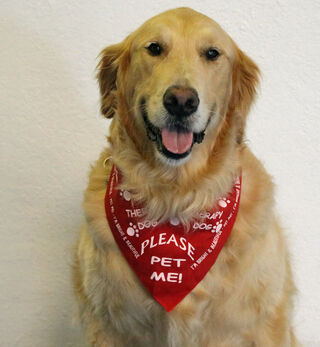Leadership
Train, Test, and Register Your Therapy Dog
Three steps to success.
Posted October 23, 2022 Reviewed by Jessica Schrader
Key points
- General obedience classes, followed by advanced therapy dog formation classes, are the best preparation for prospective therapy dog teams.
- Group classes are less expensive than private sessions and offer essential socialization opportunities.
- Your pup must enjoy interacting with others and respond confidently and immediately to your instructions to become a registered therapy dog.

If you have evaluated your pup’s temperament for suitability as a therapy dog (TD), your next steps are to refine his affiliative, biddable, and gentle characteristics through training before you can test together and become a registered, working team.
Training
From chaotic puppy play groups to invitation-only advanced training, obedience classes can help you and your dog bond as a team and polish your skills. The American Kennel Club’s Canine Good Citizen (CGC) course is available at many local dog clubs and training organizations; it is a nationally recognized threshold for basic canine obedience. Dogs pass the CGC when they successfully demonstrate 10 basic obedience behaviors and physical postures on demand, including sit, down, stay, and come. They must walk politely beside their guardian handlers on a loose leash, be non-reactive to other dogs and people, and successfully manage a brief separation from the handlers.
You might be tempted to take private lessons with your pup in the belief that you’ll both progress faster that way. Resist the urge. Group lessons provide your dog with essential opportunities for socialization with unfamiliar others; this exposure will help him mature into a confident dog who is unruffled in complex social environments. You’ll also learn more as a guardian handler by watching and interacting with other teams in training. A bonus is that high-quality small-group sessions are much more affordable than private lessons.
Competency evaluations for TD teams differ slightly according to the requirements of each TD organization, but they all require a skill demonstration beyond the CGC requirements. You and your dog will learn advanced teamwork and obedience in specialized TD training.
Many of these sessions simulate experiences that might occur during visits to community settings such as schools, nursing homes, and hospitals. For example, you and your dog should learn to work around standard medical equipment, including wheelchairs, rolling carts, and crutches. A volunteer role-player might portray a friendly stranger who approaches and, with permission, interacts with your dog. Another volunteer might role-play an infirm person who walks awkwardly or unsteadily, moans in distress, or knocks a walker to the ground. A child might be enlisted to run or skip around the room. The dog might be gently nudged or lightly touched unthreateningly by a foot, cane, or crutch, simulating the accidental contact that might occur during a visit. The dog must maintain his composure and concentration despite these distractions. Another role-player might run a vacuum, clang two pans, or slam a door while the trainer evaluates the dog’s startle response. In another exercise, you might be asked to navigate around food that is unexpectedly dropped on the floor near your dog, who must flawlessly obey your commands to “watch me” and “leave it.” These activities are intended to reinforce your dog’s calm focus on you as you lead him through increasingly complex scenarios.
Achievement of these tasks might seem impossible at the start of your training journey. However, brief, daily practice sessions over the first year or two of your dog’s life will significantly improve your leadership ability and your pup’s obedience skills. Dogs must be at least a year old to be eligible for TD testing, so give yourself at least that first year to work on your relationship and foundational training.
Testing
The testing process assesses your leadership skills, your dog’s temperament and behavior, and your mutual ability to work as a team. Testing procedures vary according to the requirements of each therapy dog organization, but they all evaluate the same fundamentals. Some therapy dog organizations are small and local, serving one geographic location. Others, like Pet Partners and Bright and Beautiful Therapy Dogs, are nationally known. Ask your trainer for advice if you’re unsure which organization to choose. Select an organization that has active membership in your area so you can benefit from TD group activities and mentoring. Ensure that your evaluator is approved by the TD organization you wish to join. You may need to wait a few months for an evaluator to be in the area, or you may need to travel to a group testing site. The TD organization will give you this information and any special instructions or equipment required to prepare for the test.
During the TD evaluation, dogs and their guardian handlers must demonstrate a mutually trusting and respectful relationship. Dogs should walk in the heel position without lagging or lunging, walk through a crowd while making left and right turns aligned with the handler, and display quiet, patient, polite behavior around unfamiliar dogs and people. They should accept petting, grooming, and gentle handling by a stranger without reluctance. They must ignore distractions and maintain focus on the guardian handler. They must demonstrate short and long stays and remain in one position (sit or down) when the handler goes out of sight for a few minutes. They must return to the guardian handler in a straight line when summoned. They should respond unequivocally, confidently, and immediately to all instructions.
Registration
Once you and your dog pass your team test, you are eligible to register with the TD organization. Registration fees vary but average between $50 to $100 per year; in exchange for this fee, you’ll receive protective insurance coverage against adverse incidents and the right to dress your pup in hard-earned therapy dog gear, such as a bandana or cloak, while volunteering. Registration typically lasts for one year, after which you’ll have to provide updated, annual proof of routine veterinary care and vaccinations before the new registration is awarded. Some organizations require re-testing annually or every few years. Many organizations pair newer members with a mentor team, so you’ll have company and support as you make your first community visits.
Train, test, and register: these three steps will start you and your pup on the adventure of a lifetime as you join together in a TD team partnership. It’s challenging, rewarding, and wonderful work that will enrich your relationship with your dog and deepen your connection to your community. Enjoy!
References
Further reading:
American Kennel Club. (n.d.). AKC Recognized Therapy Dog Organizations. Retrieved August 16, 2022, from https://www.akc.org/sports/title-recognition-program/therapy-dog-progra…
Davis, K. D. (2002). Therapy dogs: Training your dog to reach others (2nd ed.). Dogwise Publishing.
Pet Partners. (n.d.). Volunteer with Pet Partners. petpartners.org. Retrieved August 16, 2022, from https://petpartners.org/volunteer/volunteer-with-pet-partners/


